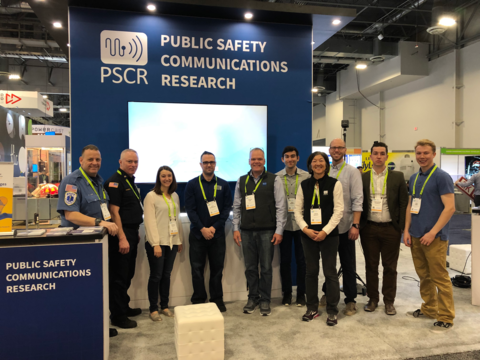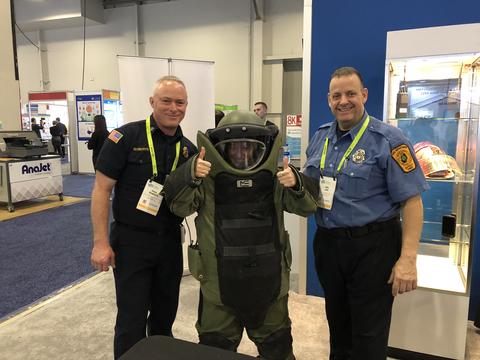PSCR Engages with Industry at CES2019
Why Public Safety Attends the Consumer Electronics Trade Show
By PSCR Staff
In January 2019, a small group of PSCR staff, students, and affiliates journeyed to Las Vegas, Nevada for four days of exhibition at the Consumer Electronics Tradeshow (CES). What follows is a high-level recap of the experience and its outcomes.

Why We Went
In an effort to increase recognition among commercial industry, the solver community, and the general public, PSCR went to CES2019 to raise awareness about its program, research, and funding opportunities. What was particularly important for us to convey to the CES audience was that PSCR is a vehicle for collaboration opportunities, specifically – though not exclusively – in the form of funding (prize challenges, grants, and cooperative agreements). In addition, we wanted the audience to envision that their products, tech, and research may be applied in a public safety use case.
In many instances, however, before we could discuss funding and partnerships, we had to convey the reason for the program. We had to educate people on the daily operations of first responders, and the communications technology challenges they endure. Therefore, we designed the PSCR exhibit around the following call to action: Experience emergency response through the eyes of Public Safety at the PSCR CES2019 booth.
What We Did
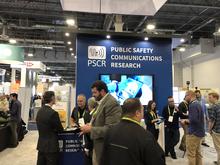
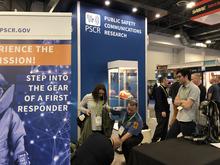
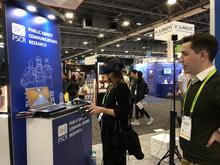
The booth PSCR staffed was at the SANDS EXPO in the wireless devices section of the show. The booth included live demonstrations, a looping slideshow presentation, and printed material with which people could engage. Passersby were intrigued predominantly by the firefighter gear – and firefighters themselves; more than a few wanted to hold, feel, and even wear the firefighter gear and bomb suit on display. Those who were bold enough to suit up into the gear - with the help of first responders Ken Link and Paul Roberts - were then surprised to imagine communicating with their commercial devices, on top of coordinating all the other life-saving equipment they were required to carry. Many of these people spoke with Ken and Paul, then went on to inquire about the PSCR program, research areas, and opportunities to get involved.
Situated next to the uniformed first responders in the booth was an augmented reality (AR) demo that also piqued the interest of people walking by—especially as the tech related to the first responders and their displayed gear.
Another draw for booth entry was the virtual reality (VR) demo, on the side opposite the first responders. Even though VR in and of itself may be expected at CES, few people consider the tech in a public safety application; we wanted to stop people in their tracks with something visually arresting, then get them thinking about how their favorite gaming and entertainment technology could be used in a public safety context. Visitors to the booth had the choice of two demos: 1) The scenario from 2018’s Prize Challenge, a VR simulation that put users in a burning office building with a Heads up Display to help them find and rescue a victim or, 2) An early prototype of what the UI/UX research portfolio is building for the next prize challenge, which focuses on haptic interfaces rather than visual ones.
The scenarios were similar but different; in both instances, users had to find and rescue victims from a burning building. However, the difference in execution showcases the progress by PSCR’s team. In response to feedback from real firefighters that the 2018 scenario was too clean cut, sterile, and cartoony, the new environment takes the form of a photorealistic office environment. More importantly, the rooms and corridors became filled from floor to ceiling with smoke, limiting visibility to barely a few feet. This major visual change was well received by the firefighters that tried the demo, all of whom remarked that the new changes made the experience much more authentic.
Ultimately, many people stopped in to demo PSCR’s VR environments, which set the stage for an upcoming funding opportunity, the Haptic Interfaces for Public Safety Prize Challenge. For the new Challenge, competitors will design and implement haptic-based solutions to help users complete difficult tasks when sight and other senses are impaired. At CES, PSCR successfully showed onlookers a VR experience they didn’t expect, prompting questions about what PSCR is, does, and how to get involved.
What We Learned
There were several takeaways from CES2019 for this group of engineers and scientists, not least of which is the fact that translating highly technical, subject-matter-specific information to a general audience requires meeting people where they are vs where we are. The exhibit team became quite skilled in this form of communication; during the course of the week, a few themes emerged that help us learn the best way to spread the PSCR message.
Common Misconceptions
"What are you selling?" was the most frequently asked question at CES, followed closely by "what do you guys make?" When you exhibit at an event centered around consumer electronics, people expect that you make something they can buy. Booth staff had to re-frame the questions and convey PSCR’s role in the greater technology sphere in order to set people straight; we are a federal research lab that develops and helps develop communications technologies benefitting first responders. Perhaps the biggest differentiator that the CES audience walked away with was knowing that PSCR actually provided funding opportunities rather than making and selling products.
Context is Everything
People everywhere are familiar with what first responders look like; the uniforms tend to be a dead giveaway. However, at CES, seeing uniformed first responders on the show floor - not responding to an emergency - is a pretty surprising sight. This is, after all, the backdrop for future consumer electronics technologies. In the context of CES, where attendees expect to see new, flashy, commercial technologies they can sell to their customers, public safety practitioners and researchers stand out. This cognitive dissonance was useful for starting conversations with new, potential stakeholders.
While not everyone who visited ended up being the target audience for a formal PSCR engagement, everyone who stopped by was worth approaching even if only to explain what PSCR does and why that mattered in communities the world over. While some people were more aware of gaps in public safety use cases, some were learning about those gaps for the first time; many had never considered that first responders work in completely unique circumstances, rendering commercial devices ineffective or inoperable. Taking the time – if even briefly – to educate the less familiar on the importance of the program and its mission was extremely important as it related to cementing the need for the PSCR program.
Even in a tech world, People make the difference
The first responders themselves were the biggest draw for people stopping by and sticking around the booth. If their booth section were a webpage, their page would have had the highest visit rate and longest average visit duration; they were simply integral in helping onlookers discover technology on a mission. This finding further reinforced PSCR’s reason for being--the stakeholders.
In addition, without a lot of flashy technology to lure people in, PSCR staff and students embraced the opportunity to educate attendees about the need to research and develop public safety communications.
What It Means
It's essential to continue raising awareness of the communications technology gaps first responders endure in their daily operations. It is especially important to demonstrate this message to a commercial industry audience who potentially have untapped resources to contribute to the cause. Reaching this audience at the events they already attend - and inviting them into the PSCR fold - is an important consideration for future PSCR efforts.
So the next time you see us somewhere federal research labs don’t usually go, remember this: it’s all to strengthen the effectiveness of our work for public safety stakeholders.
